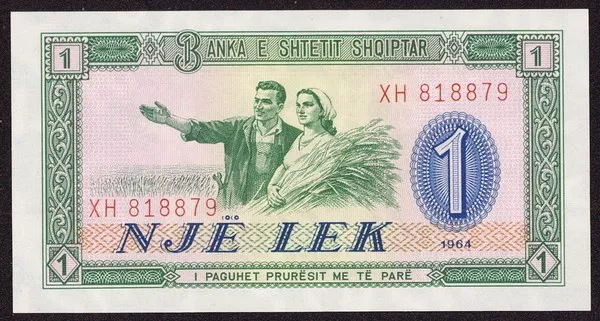The world of currencies is diverse, each telling a unique story of a nation’s economic journey. In this extensive guide, we delve into the intricacies of the Albanian Lek (ALL) currency. From its historical roots to the symbolism embedded in its design, we uncover the fascinating aspects that make the Albanian Lek a testament to Albania’s economic evolution.
Albanian Lek Currency History
1. Origins of the Lek:
The Albanian Lek has a storied history that traces its roots back to the early 20th century. Established in 1926, the Lek emerged as a symbol of Albania’s quest for economic independence. The word “Lek” itself has historical significance, reflecting an ancient Albanian term for a silver coin used during medieval times.
2. Socialist Era:
During the socialist era under Enver Hoxha, the Lek underwent changes in design and denominations. Socialist symbols and ideological elements were incorporated into the currency, reflecting the political landscape of the time.
3. Post-Communist Transition:
With the collapse of communism in the early 1990s, Albania underwent significant economic reforms. The Lek became a symbol of the nation’s transition to a market-oriented economy, embracing a new era of financial openness and stability.
Albanian Lek Currency Symbol
The symbol of a currency often encapsulates the cultural and historical identity of a nation. The Albanian Lek is represented by the symbol “L” with a forward slash (“/”) through the vertical stroke. This distinctive symbol is a visual representation of the Lek’s identity, differentiating it from other currencies on the global stage.
Albanian Lek Currency Codes
In the realm of international finance, currencies are identified by standardized codes. The Albanian Lek is no exception, with the currency codes “ALL” and numeric code “008.” These codes facilitate seamless communication in financial markets, ensuring clarity and accuracy in global transactions involving the Albanian Lek.
Albanian Lek Denominations
1. Banknotes:
Albanian Lek banknotes showcase a blend of historical figures, cultural symbols, and architectural landmarks. Denominations range from the modest 200 Lek note to the more substantial 10,000 Lek note. Each denomination offers a glimpse into Albania’s rich heritage and contemporary achievements.
200 Lek Note: Featuring a portrait of Ismail Qemali, a key figure in Albania’s declaration of independence in 1912.
500 Lek Note: Highlighting the renowned Albanian painter, Kole Idromeno.
1,000 Lek Note: Showcasing Naim Frashëri, a prominent Albanian poet and writer.
2,000 Lek Note: Featuring Dom Ndre Mjeda, a Franciscan friar and poet.
5,000 Lek Note: Honoring Eqrem Çabej, a distinguished linguist and scholar.
10,000 Lek Note: Depicting Asdreni (Alexander Moisiu), an influential figure in Albanian literature.
2. Coins:
Albanian Lek coins contribute to the monetary tapestry, offering practical denominations for daily transactions. The coins are adorned with national symbols, historical figures, and natural motifs.
1 Lek Coin: Featuring a traditional motif of a sheaf of wheat, symbolizing agricultural abundance.
5 Lek Coin: Showcasing the head of a sheep, emblematic of Albania’s agrarian heritage.
10 Lek Coin: Highlighting the iconic national symbol, the eagle, representing freedom and sovereignty.
20 Lek Coin: Featuring the Illyrian helmet, a nod to Albania’s ancient history.
50 Lek Coin: Depicting a medieval castle, symbolizing Albania’s rich historical legacy.
The Role of the Albanian Lek in Economic Growth
1. Monetary Policy:
The Bank of Albania, established in 1992, plays a pivotal role in shaping the country’s monetary policy. The bank’s efforts focus on maintaining price stability, fostering economic growth, and ensuring the overall soundness of the financial system.
2. Inflation Dynamics:
Over the years, Albania has witnessed fluctuations in inflation rates, impacting the value of the Lek. The central bank employs various tools to manage inflation and stabilize the currency, contributing to a more predictable economic environment.
3. Exchange Rate Regime:
Albania has experienced shifts in its exchange rate regime, transitioning from a fixed exchange rate system to a more flexible approach. This evolution reflects the country’s commitment to adapting to changing global economic dynamics.
Challenges and Resilience
1. Euroization:
One of the challenges facing the Albanian Lek is the widespread use of the Euro in daily transactions, a phenomenon known as “euroization.” This has implications for monetary policy effectiveness and the Lek’s role in the broader financial landscape.
2. Economic Reforms:
Albania continues to implement economic reforms aimed at enhancing competitiveness, attracting foreign investment, and fostering sustainable growth. The resilience of the Lek is closely tied to the success of these reforms.
Conclusion
In conclusion, the Albanian Lek stands as a testament to Albania’s journey through historical shifts, economic reforms, and a commitment to stability. From its humble beginnings in the early 20th century to its role in the contemporary financial landscape, the Lek encapsulates the spirit of a nation striving for prosperity and resilience on the global stage. As Albania continues to evolve, so too does the story of the Albanian Lek, an enduring symbol of economic identity and national pride.


